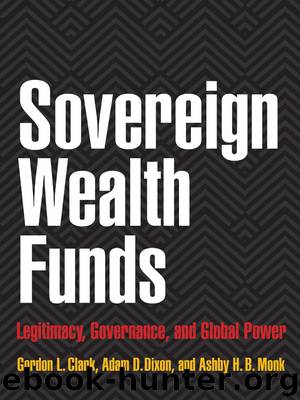Sovereign Wealth Funds by Clark Gordon L. Dixon Adam D. Monk Ashby H.B

Author:Clark, Gordon L., Dixon, Adam D., Monk, Ashby H.B.
Language: eng
Format: epub
Publisher: Princeton University Press
Published: 2013-03-18T16:00:00+00:00
* * *
7
* * *
Legitimacy, Trade, and Global Imbalances: The China Investment Corporation
As the global financial crisis accelerated through the second half of 2007, the newly established China Investment Corporation (CIC) took a US$5 billion stake in Morgan Stanley. Like many other U.S. institutions, Morgan Stanley was vulnerable to the discounting of its subprime mortgage investments and experienced rapidly eroding confidence in its capacity to withstand the rigors of market volatility. In exchange for the CIC’s investment, Morgan Stanley gave up nearly 10 percent of its common stock. With other, similarly high-profile investments in financial institutions Blackrock and JC Flowers, the Chinese government announced, in effect, that its sovereign wealth would be used to claim a share of the global financial industry. While the CIC attempted to justify its behavior on commercial and financial grounds, it has become clear that the investments were made for their strategic value. By “strategic” we mean that the success of the fund’s investments was (and is) determined from not only the perspective of shareholder value but also national stakeholder value. Indeed, as one of the world’s largest SWFs, the CIC has eschewed conventional portfolio investment in developed financial markets for strategic investment in industries and jurisdictions deemed essential to China’s long-term growth. The CIC is one element in the strategy of the Chinese government’s commitment to maximizing the country’s rate of economic growth.
The U.S. response to these investments was muted when compared to the hostility shown to proposed investments by Middle Eastern SWFs in U.S. infrastructure a couple of years prior to the financial meltdown. In some quarters, it was hoped that the CIC and other large SWFs might underwrite global financial stability, using their resources to take long-term positions in the core institutions of the global economy. It was also hoped that these investments and government-led initiatives to stabilize financial markets might forestall a deeper crisis, one that threatened to fracture the global hegemony of the Anglo-American system of financial intermediation and market exchange. These hopes were not realized, as it would be another twenty-four months before markets rallied and there was some semblance of confidence in the U.S. economy and the global banking industry.
In 2008–2009, the Chinese fund broadened its strategic focus to include the resource sector (see Haberly 2011), which was deemed to be an industry of importance for the country’s long-term development objectives. Indeed, unlike the majority of countries that sponsor SWFs, the CIC’s assets are not owed to Chinese resource endowments. Its assets derive from the accumulated dollar-denominated foreign currency reserves held by the Chinese government due to the export of consumer products by state-owned enterprises and Western corporations to developed economies’ consumer markets.
In this chapter, we offer an innovative account—rooted in international political economy, economic geography, and geopolitics—of the rise of the CIC. We argue that the CIC is not an investor governed only by concerns for long-term risk-adjusted rate of return on its investment portfolio. Rather, this chapter views the CIC as an arm of the Chinese
Download
This site does not store any files on its server. We only index and link to content provided by other sites. Please contact the content providers to delete copyright contents if any and email us, we'll remove relevant links or contents immediately.
International Integration of the Brazilian Economy by Elias C. Grivoyannis(99258)
The Radium Girls by Kate Moore(11977)
Turbulence by E. J. Noyes(7983)
Nudge - Improving Decisions about Health, Wealth, and Happiness by Thaler Sunstein(7660)
The Black Swan by Nassim Nicholas Taleb(7063)
Rich Dad Poor Dad by Robert T. Kiyosaki(6517)
Pioneering Portfolio Management by David F. Swensen(6261)
Man-made Catastrophes and Risk Information Concealment by Dmitry Chernov & Didier Sornette(5958)
Zero to One by Peter Thiel(5736)
Secrecy World by Jake Bernstein(4703)
Millionaire: The Philanderer, Gambler, and Duelist Who Invented Modern Finance by Janet Gleeson(4425)
The Age of Surveillance Capitalism by Shoshana Zuboff(4252)
Skin in the Game by Nassim Nicholas Taleb(4206)
Bullshit Jobs by David Graeber(4143)
The Money Culture by Michael Lewis(4138)
Skin in the Game: Hidden Asymmetries in Daily Life by Nassim Nicholas Taleb(3962)
The Dhandho Investor by Mohnish Pabrai(3727)
The Wisdom of Finance by Mihir Desai(3698)
Blockchain Basics by Daniel Drescher(3544)
